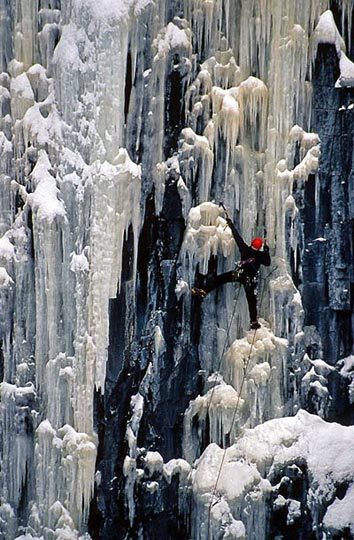
Barry Blanchard on the first ascent of The Distant Sound of Thunder (WI5/6), Little Oulmet Canyon (now known as Eagle Canyon), Ontario. [Photo] Nick Buda
Canada is a world class winter climbing destination. Of course, most equate this status with the Canadian Rockies. But for many, Ontario is the hotbed of near-limitless winter possibilities. While the landscape lacks the vertical rise of the Rockies, the sheer volume and quality of climbing make it a great winter–and summer–playground.
At Thunder Bay, in the far northwest, the accessibility of classic routes makes pre-work solos and post-work first ascents easy. Orient Bay, Nipigon and Kama Bay, in the far north, offer “alpine cragging” that is “more like mountain mixed climbing than actual mountain mixed climbing.” To the east, Marathon, Agawa Canyon and Montreal River house hundreds, if not thousands, of rock, ice and mixed routes on everything from 25-meter ice curtains to 300-meter walls that contain dozens of traditionally protected mixed lines.
This week, Alpinist presents the words and photographs of Ontario’s fixtures. Dedicated local, Nick Buda, relates some (mis)adventures while being mentored on the winter climbs of Kama Bay, Orient Bay and Thunder Bay. And a commuting climber, Stephen Gladieux, offers a window into the community on the eastern side of Lake Superior.

Rodney Swatton descending Icebreakers (WI5+), Kama Bay, Ontario. [Photo] Nick Buda
DAYS IN THE BAYS
Author: Nick Buda
KAMA BAY
Matt Giambrone is cursing. Loudly. His Twin Cities accent amuses me, and it becomes more pronounced the angrier he gets. We are standing at the base of a potential new route at Kama Bay, having completed a long and circuitous slog through rotten cliff bands and overgrown alders, over bottomless hoarfrost overlying knee-wrecking talus. I’ve just noticed his clip-leash missing from his ice tool. Fortunately for us, it’s just a few minutes back down our hard-won trail, and Matt’s soon racking for the lead.
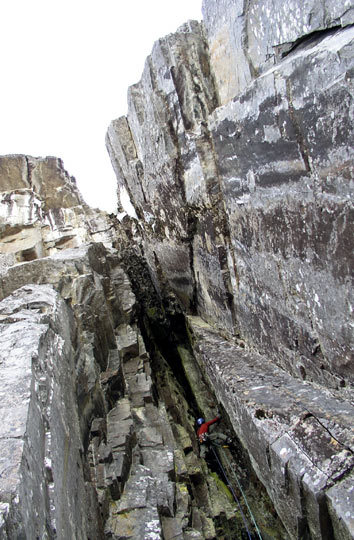
James Loveridge on the first ascent of Shelob’s Lair (M8 R/X), Kama Bay, Ontario. [Photo] Dave Pierce
I take in the vista of boreal forest and Lake Superior’s magical north shore before gasping at the seriousness of our proposed route: a steep, ephemeral smear of ice barely an inch thick for the first 80 feet, and apparently devoid of protection until the top. The ice coats an inset, rounded column with an icy, flared crack along one edge. Matt begins tapping and hooking tentatively but soon transitions to slow, deliberate movement. Watching him lead, I get lightheaded from holding my breath. It’s the first time I’ve been involved with a route like this, and I’m terrified. For three hours I watch Matt climb desperate ground, placing no real gear. Finally, he tops out with a kink in his side from constant, off-balance stemming. Following, my eyes are born to the possibilities of hard ice climbing and the massive new route potential here. The radio suggests an appropriate route name on the drive out: “Asymmetric Warfare.”
ORIENT BAY
A few winters later, conditions are exceptional at the roadside crag of Orient Bay, and I’m holding the ropes for James Loveridge. Since spending a good chunk of the previous winter establishing bolted mixed routes at The Fishery, near Nipigon, James and I have become good friends. I look forward to his wild weekend visits from Duluth. This time, the adventure comes in the form of a volley of rocks, just as James is drytooling the delicate crux of our second new route of the day. The rocks land in the snow around me, the whoomphs ever closer to my stance, exposed to the bitter northwest wind.
I grow concerned about the late hour and the building snowstorm, especially because I am content with one route and not motivated for a second. But James insists on attempting the unlikely looking line. He’s soon out of sight after traversing around a cedar tree that points out of the cliff’s solid diabase. A few calls of “watch me” are followed by elated shouting about the quality of the route. “That’s just to psyche me up,” I think. I decline following the route.
It was not until a couple of weeks later when I returned and repeated the route that I appreciated his vision, and assessment of the route’s quality. Adventures with James have developed my own potential as a climber–and have yielded a number of excellent new traditionally protected mixed routes.
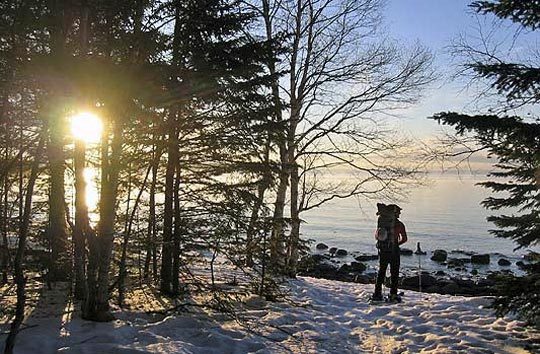
Bryce Brown takes a scenery break on the long approach to the Sleeping Giant Icefall, Sleeping Giant Provincial Park, Sibley, Ontario. [Photo] Nick Buda
THUNDER BAY
Later that winter, Bryce Brown and I decide to take advantage of some untapped potential within the city limits. We leave our car for the three-minute approach to the intimidating east face of Mt. McKay. Perched atop a short talus slope overlooking the city and the magnificent Sleeping Giant, the 200-foot face sports several large, yellow daggers flowing out of lichen-covered diabase–and an 80+ foot band of the most unstable shale imaginable. It’s home to four established routes, and there’s potential for a couple more.
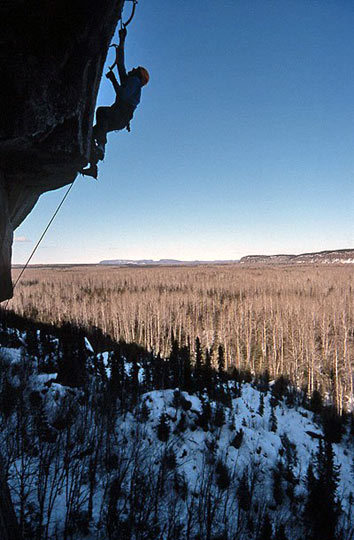
James Loveridge, a prolific first ascenionist of mixed routes throughout Ontario, on the first ascent of Tryptophan (M9), The Fishery, Thunder Bay, Ontario. Loveridge and Nick Buda spearheaded the development of the area following Buda’s first visit. An attempted repeat of Steve Russell’s Jiggin for Cod (M5 WI6, 50m) led both men to understand that collapsing beaver dams, deadfall tree epics, January temperatures below -40 degrees (one of the few temperatures where the Fahrenheit and Celsius scales correspond), killer partridge and drunken deer hunters are simply par for the course. Climbing in the region is sometimes dictated more by the approach or the weather than the route itself. [Photo] Nick Buda
After 20 feet of fat blue ice, I’m into the business: a thin, detached ribbon leading to a blank-looking roof and, high above, a large hanging dagger. Pounding a hook into a crack, I stare with disbelief as the rock shatters and the hook falls out. I place a large cam in the gaping hole that remains and will it to stay there. A move higher I repeat the same thing with a knifeblade. This time, after the rock crumbles, I try placing a bugaboo deep in the hole I’ve created, to no avail. I place no pro, move higher and realize I can’t reverse the moves I just pulled around the roof. I stem right to a corner, only to realize that the corner rocks gently; it’s just a loose block the size of a refrigerator. I’m stemming in a house of cards. I move left and lieback off my right tool, and watch with horror as the blocks move and the crack widens around my torqued pick. One move higher, I stick the cruxy “roof reach around,” only to have my pick get stuck in the thin crack. I grow scared trying to free the tool at maximum extension, my fingers going numb in the cold and slipping off the lower tool grip. With no other option, I swing onto the brittle dagger–which miraculously holds–and I’m left to battle the steep, brittle ice to the top. Doing my best not to kill Bryce with the dinner plates I’m kicking off, I’m soon constructing a convoluted belay anchor. I collect myself before we begin the mellower second pitch, the first to reach the top of this wall.
The next day I want nothing to do with a mixed route, so a partner and I head up to Nanabijou. Matt and James, both well-travelled, have proclaimed it one of the best routes anywhere, and it’s currently all ice and “easy at WI4+.” Somehow, I miss their 4+ exit and instead find myself alternately climbing and breaking off large, terrifying umbrellas. The climbing is definitely some of the wildest I’ve done, but at the top I realize I’ve had enough for now.
A few weeks later, nearing the end of the best season in the area’s ca. twenty five year climbing history, I find I’m looking for one last fix. A spring day finds me an hour’s drive from town making my third attempt at crossing Whitefish Lake to access the Artesian Wells Amphitheater. I’m with three of the “old boys,” climbers from the generation before that have been important partners, friends and mentors.
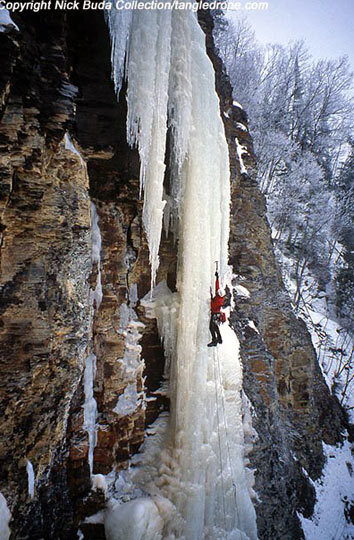
Nick Buda on the second ascent of Sideshow (WI5/5+), Whitefish Lake, Ontario. [Photo] Randy Hyvarinen
Accessing this climb has proven to be a problem for me this season. The approach consists of a frozen lake crossing followed by a slog through chest-deep snow up the drainage gully. Upon reaching the climb, one often is greeted with dangerous or impossible conditions on Artesian Wells (WI3-6). The constant northwest winds result in some of the wildest ice formations imaginable: 10-foot umbrellas and fragile curtains waiting to kill anyone foolish enough to try climbing.
But often enough, the frozen lake itself is the crux. I thought I had it figured out when I attempted it with my touring skis. Unfortunately, I broke through the ice and my skins were quickly frozen into gobs of slush. Postholing to catch up to my older and wiser partners with snowshoes, I was greeted by a local ice fishermen stepping out of his ice hut: “Why don’t ye jes use a snowmashen?”
Fortunately this time we get it right, and I succeed in making the second ascent of Sideshow, a climb Randy established the week before at WI5+, and one of the area’s best. The climb is soft and well-protected, and is a perfect way to end the season.
But it ain’t over ’till it’s over. Standing at the edge of the lake, I’m debating with Randy about wearing crampons for the crossing. The rising temps have left a smooth, arena-like sheen on the ice. Randy opts to leave his on. I mutter something about old guys and walking in crampons being hard on the knees, and I charge off without them. I make it five steps before I’m airborne and staring at my feet. The impression the frozen lake ice makes in my head is almost as big as the impact climbing in Ontario has left on me.

Jack Coulis on the second pitch of Nightfall (WI3+), Devil’s Track River, Grand Marais, Minnesota, USA. The geology that makes Ontario climbing interesting streches into what is called “The North Shore” of Minnesota. Many of the rivers that drain into the Lake Superior basin have sliced deep gorges and canyons into the escarpment that rings the northern shore of the lake. Many of these gorges feature fantastic ice climbing, depending on the climactic cooperation of that particular year. [Photo] Nick Buda
MOOSE COUNTRY
Author: Stephen Gladieux, aka “The Frenchman”
I don’t live in Canada–I’m a commuter climber–but I head north from Ann Arbor, Michigan, and drive the seven-and-a-half hours faithfully every week to meet the motley, well worn crew centered around Mad Moose Lodge. This group has been climbing, developing and worshiping Ontario ice for years. We have nicknames: Mr. Moose, The Gatchman, KJ, Billy the Fin, The Frenchman, Wilk-i-Dukes. Every time I drive down the icy gravel driveway to the Lodge, I can see friends waving and Mr. Moose standing with a chainsaw in hand and a helmet on his head, attached ear muffs sticking out wildly.
Dragging myself out of the sauna at 3 a.m. in search of more beer, I can smell the pipe smoke and the four pounds of bacon sizzling in the pan. I can see the lake rolling up onto the spray ice and feel the excitement of new climbers as I prep them for their first climbs the next day.
I climb in Moose Country, affectionately named such after the Lodge. While there is much more ice to climb in Ontario–Nipigon and Orient Bay, Marathon and Thunder Bay, Batchwana Bay and a few places named in Spanish–Cerro de Hielo–nowhere has quite the feel of Montreal River Harbor.
From the easy-access climbs within a twenty-minute trudge of Highway 17 or the bigger climbs up the river, Moose Country is unforgettable. There’s nothing like a ski up to Solo Menagerie (WI5, 90m) or Steps to Rama (WI4, 140m), and with a little more time and effort, one is quickly under the shadow of routes around 300 meters–not, ahem, counting the 100-meter snow ramp at the bottom.
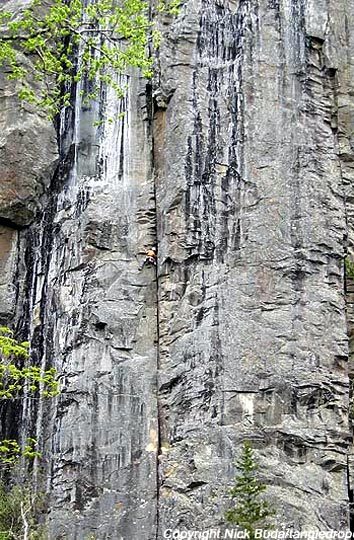
Barely visible is Shawn Robinson, near the crux of Pitch 1, Titon Crack (5.9), Tajmahwall, Orient Bay, Ontario. [Photo] Nick Buda
Frequently, though, the greatest difficulty is getting to the climb. We snowshoe to the closest, take trains to farther ones, and use a combination of train, skis and snowshoes to travel to the most distant. Recently, Justin “Lefleur” Lefevre and I started experimenting with kite-boarding kites and XC skis–wearing rando bindings–to cruise up the frozen rivers and reservoirs in a fraction of the time. It’s a hell of a way to travel, as there’s always wind near Lake Superior.
For years, new routes have been established frequently in the Montreal River Harbor area. Due to sheltering walls of the canyons, safe, solid ice can be found very late in the season. Tired of ice? There’s always virgin rock nearby. Last March Wilk-i-dukes and I climbed six pitches of ice in the morning; then, after the sun softened the ice a little too much to be safe, we put up a three pitch trad line in the afternoon warmth.
Back at Moose Lodge, Billy the Fin brought some home brew and it’s a perfect complement to Dale’s cooking. I hear the bravado of The Gatchman speaking in unison with the alcohol in his veins. I think his courage will last through the morning; I expect another WI5 classic by midday.
Like any community, we have the local heroes, distinguished for work related to access or simply for being talented climbers. We have climbers who never seem to leave the lodge (they’re damn fine company, and I never question why they are here). And we even have the same unpleasant characters found everywhere, like the local we refer to as “The Marmot,” who just cannot seem to help himself from hurting the public image of climbers.
But to all who know it well, Moose Country is a sacred home where everything is rolled together, the good and the bad–the weather, the approaches, the characters and, of course, the seductive climbing that keeps so many of us coming back.
Editor’s Note: One of the most frequented areas on the eastern side of Lake Superior, with new routes being established annually, is Agawa Canyon. There are no roads or designated foot paths into the canyon, so travel options are limited to a very long, off-trail snowshoe, a snowmobile ride over frozen reservoirs–questionable–or the Snow Train. Leaving from Sault Ste. Marie, Ontario, the train caters to the the ice climbing community, allowing a 90 kilogram weight allowance per climber, and will stop at designated mile markers throughout the canyon to drop off groups and their gear. Most groups plan at least a week stay and pack for extended camping in winter conditions. Most of the hundreds of established routes, from 70- to 150-meters long, are within a brief walk of the rail line.
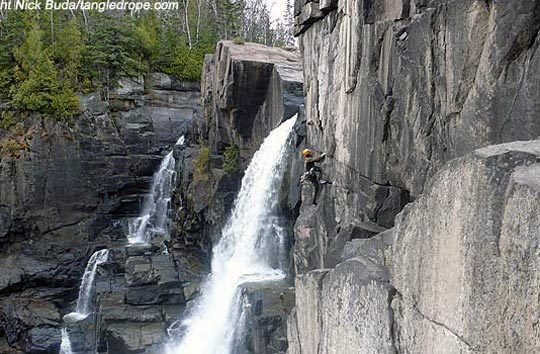
Derrik Patola leading an unnamed new route at High Falls, Pigeon River, Ontario. [Photo] Nick Buda